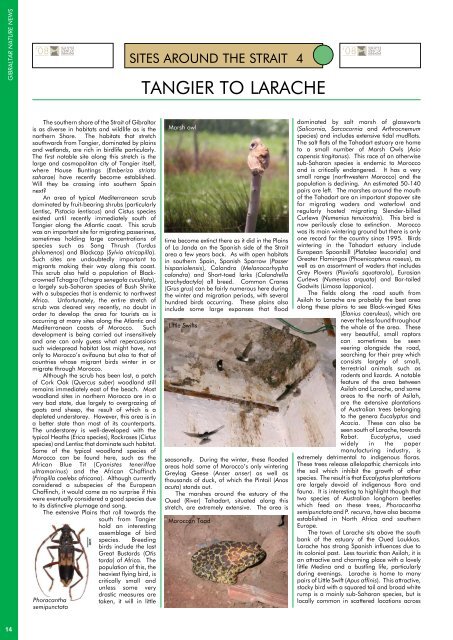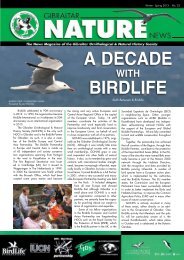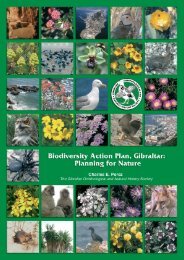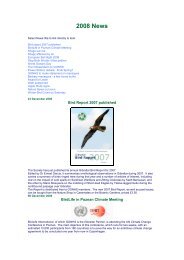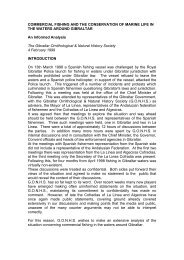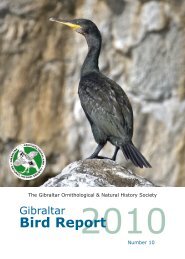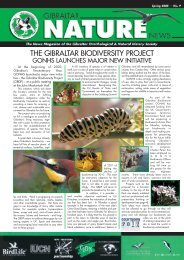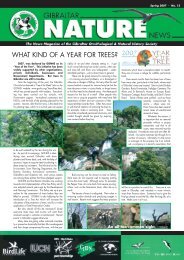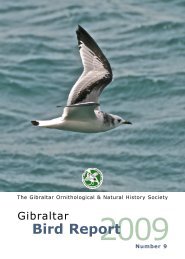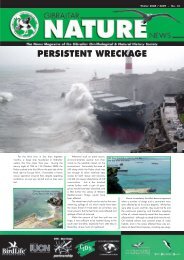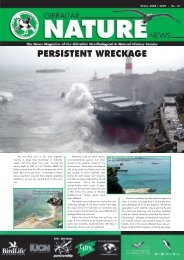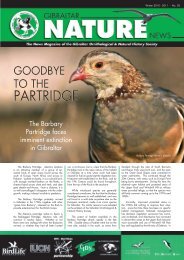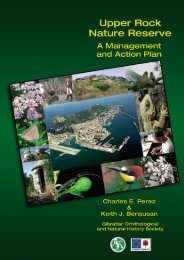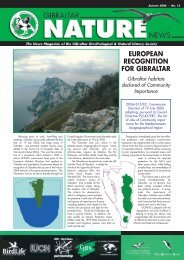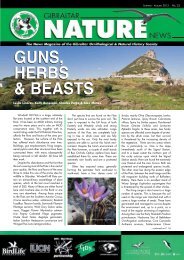No.15 - Gibraltar Ornithological & Natural History Society
No.15 - Gibraltar Ornithological & Natural History Society
No.15 - Gibraltar Ornithological & Natural History Society
You also want an ePaper? Increase the reach of your titles
YUMPU automatically turns print PDFs into web optimized ePapers that Google loves.
GIBRALTAR NATURE NEWS<br />
14<br />
The southern shore of the Strait of <strong>Gibraltar</strong><br />
is as diverse in habitats and wildlife as is the<br />
northern Shore. The habitats that stretch<br />
southwards from Tangier, dominated by plains<br />
and wetlands, are rich in birdlife particularly.<br />
The first notable site along this stretch is the<br />
large and cosmopolitan city of Tangier itself,<br />
where House Buntings (Emberiza striata<br />
saharae) have recently become established.<br />
Will they be crossing into southern Spain<br />
next?<br />
An area of typical Mediterranean scrub<br />
dominated by fruit-bearing shrubs (particularly<br />
Lentisc, Pistacia lentiscus) and Cistus species<br />
existed until recently immediately south of<br />
Tangier along the Atlantic coast. This scrub<br />
was an important site for migrating passerines,<br />
sometimes holding large concentrations of<br />
species such as Song Thrush (Turdus<br />
philomenos) and Blackcap (Sylvia atricapilla).<br />
Such sites are undoubtedly important to<br />
migrants making their way along this coast.<br />
This scrub also held a population of Blackcrowned<br />
Tchagra (Tchagra senegala cucullata),<br />
a largely sub-Saharan species of Bush Shrike<br />
with a subspecies that is endemic to northwest<br />
Africa. Unfortunately, the entire stretch of<br />
scrub was cleared very recently, no doubt in<br />
order to develop the area for tourists as is<br />
occurring at many sites along the Atlantic and<br />
Mediterranean coasts of Morocco. Such<br />
development is being carried out insensitively<br />
and one can only guess what repercussions<br />
such widespread habitat loss might have, not<br />
only to Morocco’s avifauna but also to that of<br />
countries whose migrant birds winter in or<br />
migrate through Morocco.<br />
Although the scrub has been lost, a patch<br />
of Cork Oak (Quercus suber) woodland still<br />
remains immediately east of the beach. Most<br />
woodland sites in northern Morocco are in a<br />
very bad state, due largely to overgrazing of<br />
goats and sheep, the result of which is a<br />
depleted understorey. However, this area is in<br />
a better state than most of its counterparts.<br />
The understorey is well-developed with the<br />
typical Heaths (Erica species), Rockroses (Cistus<br />
species) and Lentisc that dominate such habitat.<br />
Some of the typical woodland species of<br />
Morocco can be found here, such as the<br />
African Blue Tit (Cyanistes teneriffae<br />
ultramarinus) and the African Chaffinch<br />
(Fringilla coelebs africana). Although currently<br />
considered a subspecies of the European<br />
Chaffinch, it would come as no surprise if this<br />
were eventually considered a good species due<br />
to its distinctive plumage and song.<br />
The extensive Plains that roll towards the<br />
south from Tangier<br />
hold an interesting<br />
assemblage of bird<br />
species. Breeding<br />
birds include the last<br />
Great Bustards (Otis<br />
tarda) of Africa. The<br />
population of this, the<br />
heaviest flying bird, is<br />
critically small and<br />
unless some very<br />
Phoracantha<br />
semipunctata<br />
drastic measures are<br />
taken, it will in little<br />
SITES AROUND THE STRAIT 4<br />
TANGIER TO LARACHE<br />
Marsh owl<br />
time become extinct there as it did in the Plains<br />
of La Janda on the Spanish side of the Strait<br />
area a few years back. As with open habitats<br />
in southern Spain, Spanish Sparrow (Passer<br />
hispaniolensis), Calandra (Melanocorhypha<br />
calandra) and Short-toed larks (Calandrella<br />
brachydactyla) all breed. Common Cranes<br />
(Grus grus) can be fairly numerous here during<br />
the winter and migration periods, with several<br />
hundred birds occurring. These plains also<br />
include some large expanses that flood<br />
Little Swifts<br />
seasonally. During the winter, these flooded<br />
areas hold some of Morocco’s only wintering<br />
Greylag Geese (Anser anser) as well as<br />
thousands of duck, of which the Pintail (Anas<br />
acuta) stands out.<br />
The marshes around the estuary of the<br />
Oued (River) Tahadart, situated along this<br />
stretch, are extremely extensive. The area is<br />
Moroccan Toad<br />
dominated by salt marsh of glassworts<br />
(Salicornia, Sarcocornia and Arthrocnemum<br />
species) and includes extensive tidal mudflats.<br />
The salt flats of the Tahadart estuary are home<br />
to a small number of Marsh Owls (Asio<br />
capensis tingitanus). This race of an otherwise<br />
sub-Saharan species is endemic to Morocco<br />
and is critically endangered. It has a very<br />
small range (northwestern Morocco) and the<br />
population is declining. An estimated 50-140<br />
pairs are left. The marshes around the mouth<br />
of the Tahadart are an important stopover site<br />
for migrating waders and waterfowl and<br />
regularly hosted migrating Slender-billed<br />
Curlews (Numenius tenuirostris). This bird is<br />
now perilously close to extinction. Morocco<br />
was its main wintering ground but there is only<br />
one record for the country since 1995. Birds<br />
wintering in the Tahadart estuary include<br />
European Spoonbill (Platalea leucoridia) and<br />
Greater Flamingos (Phoenicopterus roseus), as<br />
well as an assortment of waders that includes<br />
Grey Plovers (Pluvialis squatarola), Eurasian<br />
Curlews (Numenius arquata) and Bar-tailed<br />
Godwits (Limosa lapponica).<br />
The fields along the road south from<br />
Asilah to Larache are probably the best area<br />
along these plains to see Black-winged Kites<br />
(Elanius caeruleus), which are<br />
never the less found throughout<br />
the whole of the area. These<br />
very beautiful, small raptors<br />
can sometimes be seen<br />
veering alongside the road,<br />
searching for their prey which<br />
consists largely of small,<br />
terrestrial animals such as<br />
rodents and lizards. A notable<br />
feature of the area between<br />
Asilah and Larache, and some<br />
areas to the north of Asilah,<br />
are the extensive plantations<br />
of Australian trees belonging<br />
to the genera Eucalyptus and<br />
Acacia. These can also be<br />
seen south of Larache, towards<br />
Rabat. Eucalyptus, used<br />
widely in the paper<br />
manufacturing industry, is<br />
extremely detrimental to indigenous floras.<br />
These trees release allelopathic chemicals into<br />
the soil which inhibit the growth of other<br />
species. The result is that Eucalyptus plantations<br />
are largely devoid of indigenous flora and<br />
fauna. It is interesting to highlight though that<br />
two species of Australian longhorn beetles<br />
which feed on these trees, Phoracantha<br />
semipunctata and P. recurva, have also become<br />
established in North Africa and southern<br />
Europe.<br />
The town of Larache sits above the south<br />
bank of the estuary of the Oued Loukkos.<br />
Larache has strong Spanish influences due to<br />
its colonial past. Less touristic than Asilah, it is<br />
an attractive and charming place with a lovely<br />
little Medina and a bustling life, particularly<br />
during evenings. Larache is home to many<br />
pairs of Little Swift (Apus affinis). This attractive,<br />
stocky bird with a squared tail and broad white<br />
rump is a mainly sub-Saharan species, but is<br />
locally common in scattered locations across


